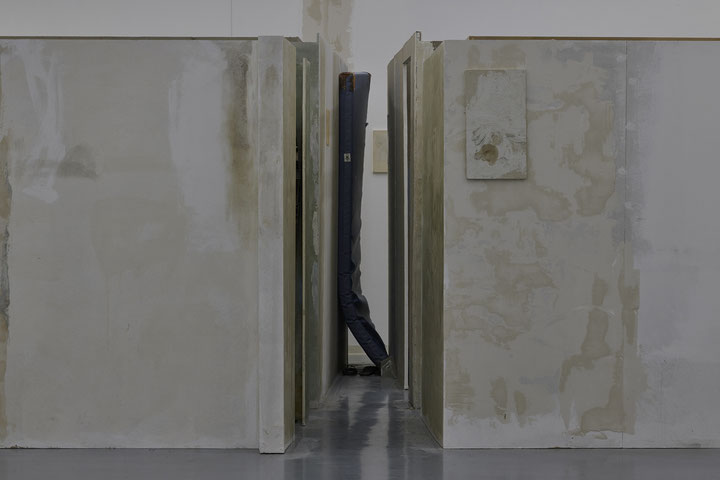Robert Smithson famously said that a building is a ruin in reverse. Such concurrent movement of construction and destruction, of growth and decomposition, is internalized in Tolia Astakhishvili’s paradoxically immersive installations. They expose and conceal at the same time their own planning and making, but they also appear as an interface between inner and outer worlds that works like a Möbius strip: it defuses any such opposition.
Half of the large hall of Bonner Kunstverein was darkened, its seven-meter-high ceiling was lowered, and the building’s pillars were multiplied, resulting in an underground colonnade, a hybrid of a courtyard and a parking lot (Entire, 2023). The space was mystified by a faint sound coming out of one pillar like a trapped presence. Other barred openings exposed more pockets and enclaves in the fabricated environment–part coulisse, part haunted house–one could glimpse the neon-lit space locked in between the two ceilings; through a square slot in a gibs wall one could peep into a white cube gallery space–a large section of the Kunstverein hall locked from all sides–with two warm-colored body print paintings by Ser Serpas (Untitled, 2023). A hidden niche made in collaboration with the artist’s father, Zurab Astakhishvili (I can’t imagine how can I die if I am so alive, 1986–), was covered floor to ceiling with hundreds of collages made of magazine clippings and faces of friends and family. In a strangely domestic air, cardboard models of architectural structures and furniture were scattered on the floor–chairs, desks, cabinets, bathtubs, windows, or doors–from every apartment the artist’s family inhabited in Tbilisi. How can we imagine our own death? Can it tell us something about ourselves? About our relationships? The father’s modeling extracts an essence from the daughter’s work in which scale is pliant. Miniatures and life-size replicas and models fill both exhibitions, at times disguised as real architecture, at times like an act of dreamy digestion: a house inside a house inside a house.
The First Finger was realized in two chapters in the Bonner Kunstverein and Berlin’s Haus am Waldsee and marks Tolia Astakhishvili’s unusual tour de force this year, with a series of solo presentations including I think it’s Closed last spring at Kunstverein Bielefeld. Based in Tbilisi and Berlin (since 2004), her work, involving an orbit of fellow creators, has now gained much coverage and resonance.
The title alludes to the diminishing, violent process in which an endangered organism auto-amputates the organs it identifies as extendable in order to survive. Yet, the two-part exhibition is an outcome of an order in which no systematic hierarchy is apparent, with no hard edges delineating distinct artworks or individual authors–an extended network of friends, family, and fellow artists; these categories are, too, fluid. The spaces of the exhibitions rather unfold in a decentralized abundance, organic and architectural, jumbled and accurately sculptured (“I listen to what the rooms tell me,” Astakhishvili says). Resisting a clear-cut hierarchy ultimately challenges given conventions of an art exhibition–so much so that it seems pointless to search for, and surprisingly find out, titles of artworks–it also enhances (or rather, sets free) paradigms of artistic practice and the “collaborative approach.”
The joint work with the father, an alpinist and retired physician, is one of several wormholes connecting Bonn with Berlin; upstairs in the Zehlendorf villa, a model of an unfinished building is placed on a windowsill (Untitled, 2023). The house was kept under construction for decades in their Tbilisi neighborhood until it was torn down, unfinished. Sun rays throw light upon its repetitive geometric cardboard grid, while all vertical lines in the room–of the grid, the window, the radiator–coincide with a massive dripping originating in a Fettecke-like gray mass in the corner pouring down. Unlike Beuys’s fat mass–smeared on the wall or piled on a chair–this corner seems to belong to the organism of The First Finger house that bleeds and leaks, cracks and threatens to turn against its passing inhabitants.
Precisely these states in between destruction and construction are at the heart of Astakhishvili’s undertaking, which exposes the viscera, veins, and skeleton of buildings (in Bonn, the smooth linoleum gallery floor was excavated, laying bare the rusty pipes running underneath among piles of sandy earth). Astakhishvili activates architecture against itself, unraveling its mechanisms of covering up, of occupying territory, but also of providing shelter as an elongation of the body: a defense from instability or a collapse outside.
This could be seen in the neat, absurd, and moving construction in the upper floor of Haus am Waldsee where a sealed rectangle made of galvanized steel hoarding panels, the kind used to fence construction sites, was thrust into the villa’s domestic layout, overpowering its harmonic dimensions and maneuvering movement of visitors in unpredicted pace and directions. Ambiguous sound reverberated from its inside, coinciding with the fragmentary figures featured in two neighboring delicate drawings by Antonin Artaud (Untitled, ca. 1947) and black-and-white photographs by Alvin Baltrop (The Piers, 1975-1986) which were (literally) framed by the supplementary constructions to the building.
A layer of patina–shoe traces, handprints, snow spray–covered almost all the plywood and gibs surrogate walls and doors. The resulting effect was double: the construction is disguised as inconspicuous, a real part of the building, and yet we find ourselves in a total, willfully dysfunctional fabrication, an image.
